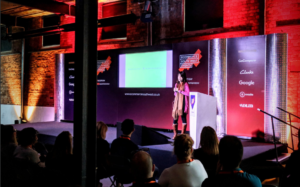


On Thursday 19th October, our Content and PPC Executive, Adrienne and Scott, headed to Paintworks, Bristol for eCommerce South West.
The event, which included speakers from GoCompare, the Met Office, and Clarks, explored ways to transform and improve digital pathways in the e-commerce (online retail) industry.
Warren Knight
Warren Knight, social media expert and author of #ThinkDigitalFirst, gave the first talk.
He explained that there are three crucial brand stages:
- Early – to engage the customer
- Middle – tailoring the service to the customer
- Late – following up with the customer e.g. a phone call/email
Different tactics should be adopted for customers at each stage of the process to guide them to contact or purchase.
For example:
- Early – offer a discount code on first purchase by giving email address
- Middle - provide product details and FAQ’s
- Late – send customer emails on offers and new products
Warren stated that potential customers online are touched by a brand eight times before purchasing. This just shows how important digital marketing is, especially B2C social media channels, where the initial brand recognition is usually built. Online, your brand’s tone of voice should be influenced by a mixture of what you’re offering, your marketplace’s offering, and your customer’s needs. It's also important that the experience that the product can offer, and the lifestyle that customers will buy into is sold, rather than the product itself.
Content is a huge factor in achieving this, which can include podcasts, written content, visuals, videos and live streaming. Your brand will also benefit from being much more search-friendly as Google will index websites with written content 434% more.
Warren stated that it’s important that you cater for people on the platform that they like to use. For example, 54% of users are digital natives, meaning that they don’t want to be taken off site. Instead, tailor the experience for each platform instead of just posting links to other pages. Provide personalised choices to your customers, so that they feel like they’re in control.
Don’t give your users a long contact form, research has found that there’s a higher conversion rate if they are asked for one thing. It’s quick for people with a short attention span, and people are a lot less likely to want to give an unknown company their personal details. Who isn’t put off when they’re faced with a three-page long form asking for your life story?
Tom Sanger and Paul Randall
Tom Sangers, Head of Search, and Paul Randall, a UX (user experience) architect, from Evosite discussed the customer journey and how to ensure that they click on to the next step.
Tom and Paul said that the key to this is by personalising this for users at different points of the journey (from first visit, to checkout/contact). This can be done by validating why the user is there. For example, Dropbox’s website copy, "Even if your computer has a meltdown or your phone goes for a swim, your stuff is always safe in Dropbox" validates the user’s need for their files to be protected.
The speakers also discussed the use of persuasion by framing price ranges. A common technique often used by restaurants is by arranging the most expensive items at the top and bottom of the menu, in contrast the medium-priced meals will seem like a bargain. Strategically designed CTA (Call to Action) buttons are another great way to guide users towards what you want them to do, and a list of Q&A’s makes life easier for you and the customer.
Tom and Paul’s top tips were to:
- Be memorable
- Always ethical
- Have a fast site
- No broken pages
- Research competitors
- Talk to not at
Dr. Chui Chui Tan, Strategic Consultant from Beyō Global gave an insightful presentation on how crucial localisation is in reaching international customers.
Rather than adopting the exact same business structure which is directly translated and with identical products and offerings, the context of the country must be understood. Chui Chui explained that outside research on customer habits and norms should be undertaken to tweak your marketing accordingly.
Chui Chui said that content, features, visuals, platforms used need to be localised. Some images may cause offence in other countries and certain platforms may not be accessible e.g. Facebook in China. The last thing you want to do is to upset your customers.
As well as understanding the customer, laws, and regulations vary from country to country, so it’s best to stay on the right side of the law!
It was a great day to meet people in the digital marketing industries and an opportunity to learn more to add to our current tactics and strategies. We never stop learning!
